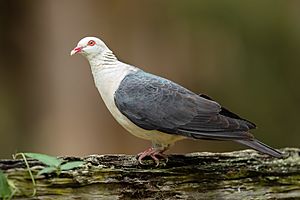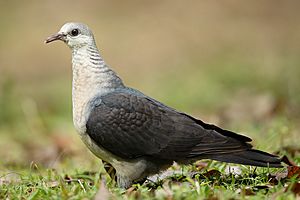White-headed pigeon facts for kids
Quick facts for kids White-headed pigeon |
|
|---|---|
 |
|
| male | |
 |
|
| female | |
| Conservation status | |
| Scientific classification | |
| Genus: |
Columba
|
| Species: |
leucomela
|
 |
|
| Distribution of the white-headed pigeon | |
The white-headed pigeon (Columba leucomela) is a pigeon native to the east coast of Australia, belonging to the same genus as the domestic pigeon C. livia.
The pigeon's habitat is from Cooktown, Queensland to southern New South Wales, with increasing numbers now found in eastern Victoria. It can commonly be found in tropical regions, subtropical rainforest, scrub, watercourses and street trees. Since colonisation of Australia, their numbers have decreased but they have thrived on the introduced Camphor laurel (Cinnamomum camphora).
The white-headed pigeon's nest generally consists of scanty twigs and is usually placed high in canopy up to 18 metres. It tends to lay one cream-white egg. Breeding is mostly from October to December.
The size of the pigeon varies from about 38 to 41 centimetres (15.2 to 16.4 inches). Plumage consists of a white head and breast with a glossy back area. Wings and tail are black. The bill is red with a yellowish tip. The eye ring and legs are red and the eyes are pale orange or yellow. Juveniles have a grey crown and breast.
These pigeons are often found alone, in pairs or in small flocks. They are very quiet and elusive. Their flight is swift and direct. Their call is loud and gruff sounding like "WHOO!" followed by a gruff inhalation sounding "uk" (repeated three times). Sometimes the call is a low "oom".
White-headed pigeons feed on fruit in canopy but can also feed on the ground in the open. It also eats fallen grains in cornfields.
- Pizzey and Knight, "Field Guide to the Birds of Australia", Angus & Robertson, ISBN: 0-207-19691-5
- Trounsen and Trounsen, "Australian Birds: A Concise Photographic Field Guide, Cameron House. ISBN: 1-875999-47-7.
See also
 In Spanish: Paloma blanquinegra para niños
In Spanish: Paloma blanquinegra para niños


